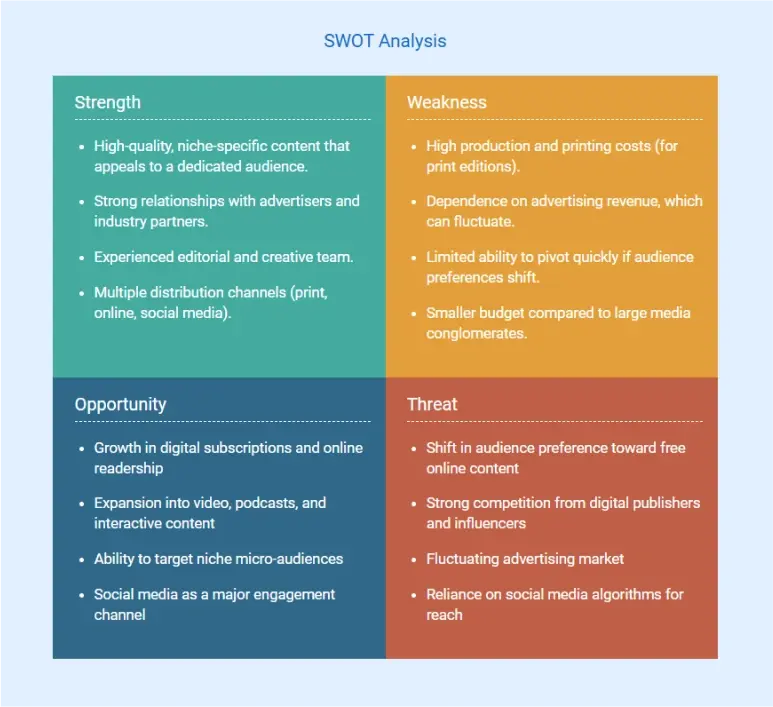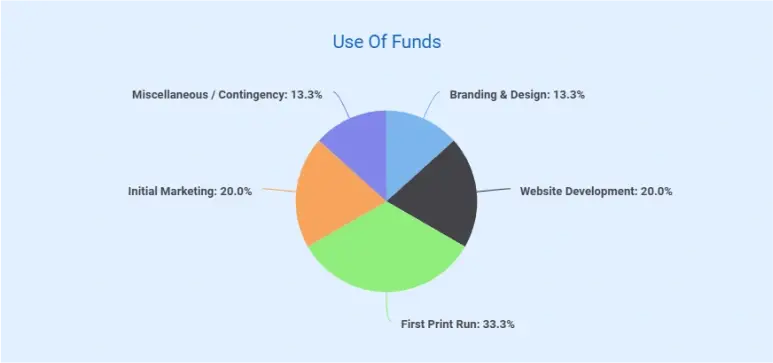Launching a magazine is exciting, but it takes more than great ideas and eye-catching covers. You need a clear picture of your audience, a plan to reach them, a way to manage operating costs, and a strategy to attract advertisers.
And the reality is, deadlines come faster than you expect, costs add up quickly, and without a clear plan, it’s easy to lose your focus.
That’s why we’ve created this magazine business plan template to help you organize your ideas, set your budget, and map out a clear way to grow. So you can focus on creating a magazine people want to read.
Keep reading for more guidance on creating a plan ready for real-world use, whether for loans or investment.
How to write a magazine business plan?
Great magazines combine creativity with strategy. This guide shows you how to plan the business side so your publication can grow, attract readers, and generate revenue:
1. Executive Summary
The executive summary is a snapshot of your entire magazine business plan. It’s often the first section in your document, but it should be written last, once all other sections are complete. This ensures it reflects your full plan accurately.
Cover these points:
- What your magazine is and where it will operate (niche, format, location, or market focus)
- Your mission and vision (what the magazine stands for and long-term goals)
- Your competitive edge (unique content approach, audience, contributors, or distribution)
- Your target audience (reader profile and why they’ll choose your magazine)
- Funding needs, if applicable (amount required and main uses)
- Financial outlook (revenue model and key financial targets)
Overall, make this section concise, preferably 1-2 pages only. The goal is to give potential investors, partners, or lenders enough information to make them read further into your plan.
Say goodbye to boring templates
Build your business plan faster and easier with AI
Plans starting from $14/month

2. Business Overview
The business overview section is where you introduce your magazine business in detail. By the time the reader finishes reading, they should be able to know exactly what your magazine is and why it exists.
Here’s what you should mention in this section:
Location and structure
Start by mentioning: Where you’re based, whether you work with a local or remote team, and how the business is structured (sole proprietorship, LLC, etc.).
Magazine concept
Then, talk about your magazine topic, tone, and style. Be specific here. “A lifestyle magazine” is vague, but “a quarterly lifestyle magazine for new parents, with a warm, practical tone” tells the reader a lot more.
Background and timeline
If your magazine business is already running, include when it was started and how it came to life.
If you’re still in the planning phase, share your launch date and any early milestones (like building your team or securing contributors).
Purpose, mission, and vision
State why your magazine exists (purpose), what you want to accomplish (mission), and what you want to grow up to in the long run (vision).
Goals
Set a few clear targets for the first 1–3 years. This could be subscriber numbers, ad sales, partnerships, or expansion plans.
While planning, make sure the tone sounds natural and contains real facts. Use no buzzwords or exaggerated statements that serve no purpose in adding data.
3. Market Analysis
Before you start publishing your editions, it’s important to know who you’re publishing for and what space you’re in.
Here are the main elements to include in your market analysis:
Industry overview
Start by giving a clear snapshot of the magazine publishing industry, focusing on size, growth potential, and key trends.
Mention the main formats (print, digital, hybrid) and how the market is shifting. If you have credible data, use it to support your points; for example, the global publishing market is projected to grow by $14.5 billion between 2024 and 2029.

Then, briefly connect this to your magazine niche. Is it a growing category like wellness or sustainable fashion, or is there any local scene with untapped potential?
Target audience
Define exactly who will read your magazine. Go beyond general labels like “general public” and focus on a clear profile.
- Demographics: Age, gender, location, and income range.
- Interests & habits: What topics they care about, how they consume content (print vs. digital), and what magazines they already read.
If possible, create two or three reader personas with a name, short bio, and example preferences.
Competition
List both direct competitors (similar magazines) and indirect ones (blogs, YouTube channels, podcasts). Compare their strengths, weaknesses, pricing, publishing frequency, and ad rates.
Look for opportunities where they’re falling short; these gaps can shape your positioning.
Market opportunity
Wrap up your market analysis by showing exactly how your magazine can succeed in this environment. Ask yourself:
- Is there a gap in the market?
- An underserved or misrepresented community?
- A tone, format, or approach no one’s doing well yet?
These are the kinds of insights that move your plan from “just another magazine” to something with a clear purpose and positioning.
If required, you can do a quick SWOT analysis. It’s a simple way to see what you’re good at, where you might struggle, and the opportunities you can tap into.
Check this example:

4. Products And Services
This section outlines what you’re offering to readers, partners, and advertisers and how those offerings turn into revenue.
Outline what kind of content you’ll publish. Common types include:
- Feature articles
- Interviews
- Reviews or roundups
- Photo essays or visual storytelling
- Opinion pieces or editorials
Further, ask yourself a few questions to guide your direction :
What kind of stories or coverage will set your magazine apart? Will your tone be serious, playful, investigative, or design-first?
Answering these will help define your magazine’s unique identity and make it easier to communicate your vision to investors, advertisers, and partners.
Also, consider how your magazine can serve as a platform for advertisers and collaborators to connect with your audience. Potential offerings include:
- Print Ad placements – Full‑page, half‑page, or quarter‑page ads in premium positions.
- Digital Ad packages – Website banners, newsletter features, sponsored social posts.
- Branded content – Sponsored articles or advertorials aligned with your editorial style.
- Event sponsorship – Co‑branded live events, panels, or pop‑up experiences.
Along with the above details, it’s a good place to mention if you want to grow out (if planned) into other formats such as books, podcasts, and/or educational material.
5. Sales And Marketing Plan
Once you’ve figured out what your magazine will offer, the next question is: How will people find it? This section helps you map out how to build awareness, grow your audience, and eventually turn that audience into revenue.
Before you choose where to promote your magazine, decide how you want it to be perceived. Are you a high‑end lifestyle brand, a niche expert publication, or a community-driven zine?
Your positioning influences everything, from tone and pricing to design choices and marketing channels.
Start by choosing a few marketing channels:
| Channel type | When to use it | Examples |
|---|---|---|
| Social media | Visual, culture, or youth-focused content | :Instagram, TikTok |
| Professional media | B2B or knowledge-based content | LinkedIn, email newsletters |
| Community spaces | Niche or grassroots topics | Reddit, Discord, WhatsApp groups |
| Owned platforms | Long-term growth or search-driven traffic | Your own website with SEO-optimized blogs |
| Offline marketing | Local or print-heavy strategy | Cafes, bookstores, local events, and flyers |
And if you’re planning a launch campaign, consider:
- Early bird waitlist perks
- Giveaway for the first 100 subscribers
- Content countdown on social handles
- Featuring well-known contributors to draw attention
Attracting readers is just the first step; keeping them engaged is where real growth happens.
The following are some of the ways to help boost retention:
- Offer subscriber-only perks like early access, behind-the-scenes content, or bonus features
- Send reminders before subscriptions expire
- Run surveys to understand what your audience wants, and use the feedback to shape content
- Engage the community through polls, commenting, or live question-and-answer sessions
Once you have even a small but engaged audience, you can start pitching ads and partnerships. Prepare a rate card with pricing, audience data, and reach. Offer bundled packages (print + digital + social).
6. Operations Plan
The operational plan section should cover the day-to-day business processes that will keep your publication running smoothly and consistently. This will give readers a clear picture of how the process moves from concept to finished publication.
Hence, try to discuss all the operational intricacies of magazine publishing and distribution, such as:
Core workflow
See the process that goes into the publication of an edition:
- Step 1: Content planning by setting deadlines, assigning stories, and deciding themes for the issue.
- Step 2: Content creation through writing, photography, illustration, and editing.
- Step 3: Design and layout include creating page designs, choosing the cover, and finalizing the overall layout.
- Step 4: Proofing and approval for accuracy, grammar, and brand consistency.
- Step 5: Printing and publishing with physical production or uploading the digital edition.
- Step 6: Distribution, which delivers the magazine to subscribers, retail outlets, or online platforms for readers.
Staffing requirements
List the roles you’re hiring or planning to hire, keeping them realistic for your magazine’s size.
Many small magazines start with a few core people and bring in freelancers when needed. Few hires you might need: Writers, Art director, photographers, advertising & sales, etc.
Tools & technology
List the main tools and technologies you’ll use to run your magazine efficiently. Examples include:
- Publishing software (Adobe InDesign, Canva Pro, etc.)
- Project management tools (Trello, Asana) for tracking deadlines
- Distribution channels (postal service, courier partners, digital platforms)
Quality & compliance measures
Detail how you’ll maintain high editorial standards and meet legal requirements.
This could involve a thorough proofing process to catch errors, ensuring all images and text have proper copyright permissions, and following advertising and publishing regulations (if applicable).
7. Management Team
A magazine’s success depends on the people shaping its content, vision, and operations. This section introduces the core team responsible for running the business.
Start with your leadership team, such as the founder or co-founders, editor-in-chief, or creative director. Then, briefly describe their background, relevant experience, and responsibilities in the business.
For example, if your editor has a decade of publishing experience or your marketing lead has grown online communities before, mention it.
If you’re just starting and don’t yet have a full team, clarify the way you’ll fill the gaps. This could include the use of freelance writers or the part-time employment of a designer.
You can also include an organizational chart, which might look like this:

Include any outside advisers or collaborators who have credibility, such as experienced journalists, publishers, etc.
In short, this section gives confidence that your magazine business is backed by people who can bring it to life and run it sustainably.
8. Financial Plan
A magazine business’s financial health depends on balancing production quality with sustainable spending. You don’t need an overly complicated budget to start, but you do need a clear view of your main costs.
Start by grouping your expenses into broad categories, such as production, content creation, marketing, and technology.
For each category, estimate the amount you’ll spend and note whether it’s a fixed cost (stays the same each month) or a variable cost (changes depending on sales or circulation).
After that, work out your expected income streams and how they match against expenses. This will help you estimate your break-even point, where income covers all your fixed costs.
You can also include critical financial statements to give a fuller picture of your monetary health and viability. They are:
- Income statement (profit and loss over a set period)
- Cash flow statement (inflow and outflow of money in the business)
- Balance sheet (assets, liabilities, and equity at a point in time)
- Break-even analysis (when your revenue is equal to all the fixed costs)
Along with that, if you are looking for funding, state how much capital you need to launch and operate, and explain how you plan to use it. For example:
“BrightCity Arts requires $15,000 in startup funding to cover branding, website, first print run, and initial marketing. This will support the production of the first three issues while building subscription and advertising revenue.”
Here’s how those funds are categorized:

9. Appendix
The appendix is where you place any extra information that supports your business plan but would clutter the main sections. Keep it organized so readers can easily find what they need.
You might include:
- Sample magazine pages or mock‑ups.
- Market research data and reader surveys.
- Advertiser rate card and media kit.
- Partnership or distribution agreements.
- Analysis visuals (if not already included in the section).
If you have multiple items, label each clearly and consider adding a mini table of contents for this section. This helps the readers to quickly navigate and reference the information when needed.
Download a free magazine business plan template
Ready to start writing your own magazine business plan, but not sure where to begin? No problem, download our free magazine business plan template PDF to get started.
This professionally designed template is built specifically for magazine publishers. It includes practical prompts, real‑world examples, and a structure that works for attracting advertisers, securing funding, and running a profitable, well‑organized magazine.
The Quickest Way to turn a Business Idea into a Business Plan
Fill-in-the-blanks and automatic financials make it easy.
Summary
Now that you’ve seen how to put together a clear, compelling magazine business plan, it’s easier for you to define your vision, connect with your audience, and build a publication that lasts.
But if you’re still not sure where to start or want to speed up the process, Upmetrics can help.
With an advanced AI Assistant, financial forecasting features, a pitch deck builder, and market research tools, it lets you draft a comprehensive business plan in minutes.
So, why wait? Start planning for your magazine business plan today!



